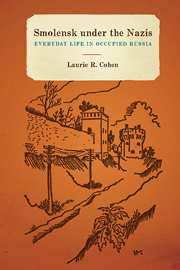Book contents
- Frontmatter
- Contents
- Acknowledgments
- Abbreviations
- Introduction
- Part 1 Methodologies
- Part 2 A Record of the War and Occupation
- 2 Between Invasion and Liberation: Everyday Life and Loyalties Prior to the German-Soviet War
- 3 Defense and Surrender of Smolensk
- 4 “Normalcy”
- 5 Occupation Atrocities and War Crimes
- Part 3 Popular Attitudes, Propaganda, and Enemy Imagery
- Part 4 Restoration and Reconstruction
- Conclusion
- Notes
- Bibliography
- Index
5 - Occupation Atrocities and War Crimes
from Part 2 - A Record of the War and Occupation
Published online by Cambridge University Press: 05 December 2013
- Frontmatter
- Contents
- Acknowledgments
- Abbreviations
- Introduction
- Part 1 Methodologies
- Part 2 A Record of the War and Occupation
- 2 Between Invasion and Liberation: Everyday Life and Loyalties Prior to the German-Soviet War
- 3 Defense and Surrender of Smolensk
- 4 “Normalcy”
- 5 Occupation Atrocities and War Crimes
- Part 3 Popular Attitudes, Propaganda, and Enemy Imagery
- Part 4 Restoration and Reconstruction
- Conclusion
- Notes
- Bibliography
- Index
Summary
While we, the soldiers on the front lines, were entitled to get ourselves shot dead over there, the SS in our rears were conducting a truly sickening business.
—Alexander Stahlberg, 1942Nazi-German war policies in the Soviet Union entailed methodical terror and crimes against humanity. Indeed, acts of violence appeared wherever German forces were present, in Smolensk as elsewhere. These acts included the systematic starvation and killings of prisoners of war as well as civilians, especially Jews, Communist Party commissars, Roma, the disabled, and children. German soldiers also raped Russian women. Actions such as these depict an even more somber aspect of everyday life than both the one described in the previous chapter and the one typically depicted in the local Russian-language paper, Novyi put'. This chapter examines these atrocities as well as general war crimes committed by the Nazi forces, such as the ransacking of property (private, state, and cultural), the imprisonment and torture of criminal suspects, and the kidnapping and deportation of civilians to be used as forced laborers.
Descriptive personal accounts and opinions by three of my interviewees—as well as other written testaments—are once again integrated into the narrative. Nadia, for example, saw the corpses of Soviet prisoners of war in downtown Smolensk in the fall of 1941. She also described her arrest and imprisonment by the Gestapo. Tania was tortured, and Vladimir offered a vivid account of the Jewish ghetto massacre and his survival.
- Type
- Chapter
- Information
- Smolensk under the NazisEveryday Life in Occupied Russia, pp. 96 - 132Publisher: Boydell & BrewerPrint publication year: 2013

